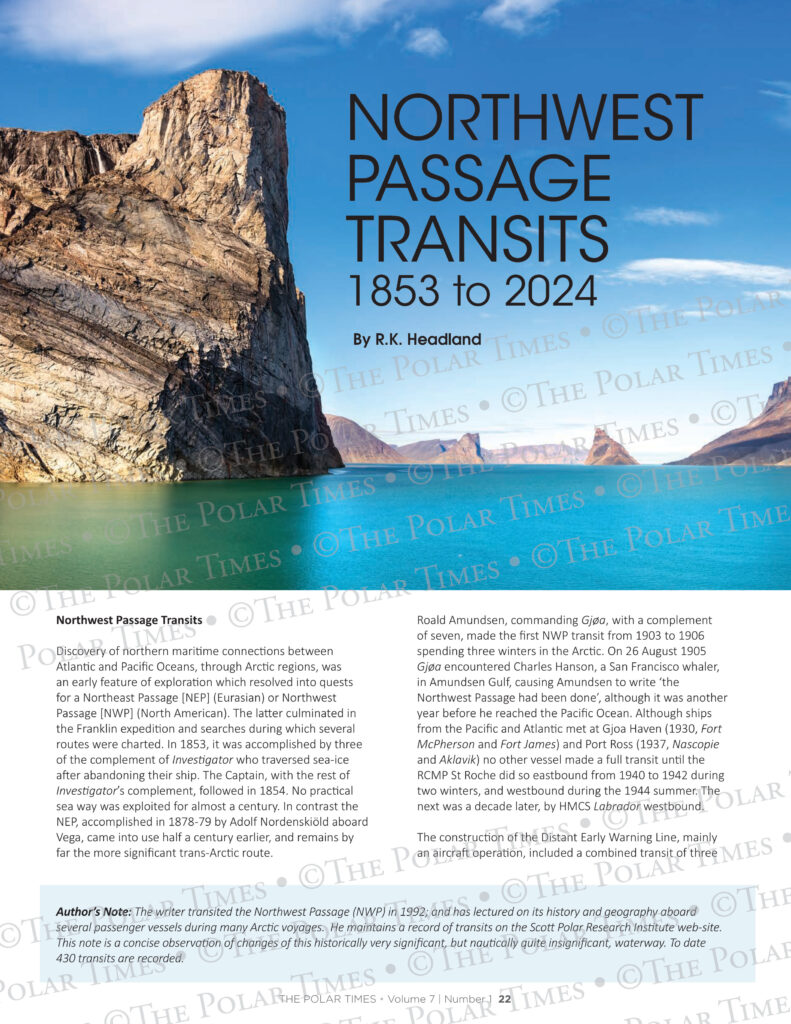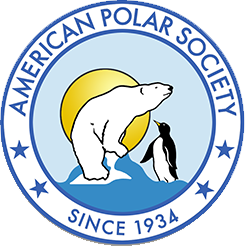
Covering the Poles for over 90 years
The Polar Times is the semi-annual magazine of the American Polar Society. Join the American Polar Society to receive the magazine in your mailbox twice per year to keep informed about what is happening in the Arctic and Antarctica.
Sample from the current magazine
These articles are only available in the print addition of The Polar Times. In addition to the below teaser about the history of Northwest Passage transits from 1853 to 2024 by R.K. Headland, readers of the Spring/Summer The Polar Times can read the report by Mariah Erkloo of the Arctic Youth Conference 2025, Krill Fishing in the CCAMLR Agreements by Claire Christian, An Inuit Oral History of the Franklin Expedition by Russell A. Potter, about the beautiful art by our Featured Artist, David McEowan, and many other articles about the two polar regions.

Discovery of northern maritime connections between Atlantic and Pacific Oceans, through Arctic regions, was an early feature of exploration which resolved into quests for a Northeast Passage NEP or Northwest Passage [NWP] (North American). The latter culminated in the Franklin expedition and searches during which several routes were charted. In 1853, it was accomplished by three of the complement of Investigator who traversed sea-ice after abandoning their ship. The Captain, with the rest of Investigator’s complement, followed in 1854. No practical sea way was exploited for almost a century. In contrast the NEP, accomplished in 1878-79 by Adolf Nordenskiöld aboard Vega, came into use half a century earlier, and remains by far the more significant trans-Arctic route.
Roald Amundsen, commanding Gjøa, with a complement of seven, made the first NWP transit from 1903 to 1906 spending three winters in the Arctic. On 26 August 1905 Gjøa encountered Charles Hanson, a San Francisco whaler, in Amundsen Gulf, causing Amundsen to write ‘the Northwest Passage had been done’, although it was another year before he reached the Pacific Ocean. Although ships from the Pacific and Atlantic met at Gjoa Haven (1930, Fort McPherson and Fort James) and Port Ross (1937, Nascopie and Aklavik) no other vessel made a full transit until the RCMP St Roche did so eastbound from 1940 to 1942 during two winters, and westbound during the 1944 summer. The next was a decade later, by HMCS Labrador westbound.
Author’s Note: The writer transited the Northwest Passage (NWP) in 1992; and has lectured on its history and geography aboard several passenger vessels during many Arctic voyages. He maintains a record of transits on the Scott Polar Research Institute web-site. This note is a concise observation of changes of this historically very significant, but nautically quite insignificant, waterway. To date 430 transits are recorded.
The TPS Vault
The American Polar Society has one of the largest, if not the largest, archives of articles about U.S. activities in the polar region in the form of The Polar Times. We are in the process of digitizing copies and making them available to APS member. Below you will find pictures and snippets of stories that caught our attention as we go through this extensive process. We encourage anyone interested in polar history to join the APS to obtain access to this and other articles from our extensive archives. Please note that these articles have not been altered, edited or updated in order to preserve them in their historical context. Occasionally the digitization process introduces transcription errors or other problems; we are continuing to work to improve these archived versions while not editorializing them.

“Navy Rescues 18 From Melting Arctic Ice Island” was the lead story for the June 1965 edition of The Polar Times. (The 18 individuals were working at the U.S. Navy’s Arlis 2 research station.) Additional polar science articles include “ONR Arctic Research Laboratory”, “Scientists Report on Species Move” (about the new theory developed by a team of American and Soviet scientists of a Bering Strait land bridge that connected Alaska and Siberia), “US Army Scientists Continuing Polar Research in Greenland,” and “Computer an aid in Ocean Studies..”
